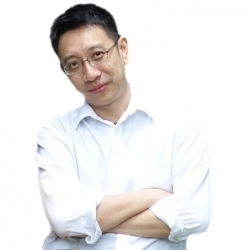As a child, I fondled my grandfather’s bones. Whole fragments of his skull and hip, retaining their shape despite the intense crematorial flames, streaked with auroreal hues from the drugs he had taken before his passing, flaking white ash as we placed them into an urn by hand, one bereaved family member after another in strict hierarchical order. Placed in a high-rise columbarium niche designated by numbered coordinates, his remains sealed away from human sight, never to be returned to earth.
Few things prepare the Singaporean mind to apprehend mortality. We mandate cremation over burial and exhume centuries-old graveyards for land, ever scarce, to build on. There is constant churn: the dead must give way to the living. Our tiny island city-state owes its improbable sovereign existence to a tumultuous merger with, and then traumatic ejection from, the post-British Federation of Malaysia in the mid-1960s. The renunciation of dead dreams and contentious history has since become a matter of national survival.
A country that must pave over its past becomes facile in the art of forgetting. To make room for the future, what had come before has had to be set aside, or else rendered inert, safely sterile. A burgeoning port settled by immigrant and regional peoples yields its haphazard, organic core to superstructures of steel, reinforced concrete, and clinical orderliness. Staying lean, trimmed to the bone socially and politically in order to focus on earning a living in a cutthroat world, Singaporeans have become, improbably, among the most affluent in the world after four decades of unsentimental economic development. Amnesia has its perks.
What to make of bones in a city that makes space for none? The contributors to this issue of FUSION tackle the question in a manner characteristic of the development of Singaporean letters in general: there is of course resistance, lament, and pushback, but there is also accommodation, synthesis, and range. Some—including, but not limited to, the members of the transitional generation now in their sixties and older who witnessed the dream of an integrated, multicultural pan-Malayan society crushed—attempt an exhumation of the spirit. Chinese literary veteran Yeng Pway Ngon, seasoned Malay wordsmith Rafaat Hamzah, and Tamil dramaturge Elangovan all have bones to pick with the crass materialism, soporific media, shallow politics, and state paternalism that have rendered, in their view, a once-vigorous people impotent and spineless. Theirs are fighting words. Nor is this a metaphor stretched too thin: a lack of “bone spirit” (e.g., the Chinese 骨气) carries with it the force of idiom in many of the cultural traditions that underpin Singaporean society.
Poets such as Yeng and Rafaat, writing from once-powerful vernacular traditions driven to near-extinction by the homogenising force of national development within the space of a generation, are pit against the loss of a cultural marrow from which a grounded sense of self and spirit might have been drawn. The doing away with ancient rites and sites of death and burial, for instance, has been regarded as disruptive to deeply held beliefs about family, clan, and community continuity. Some argue this effect was fully intended, to break the back of tightly knit communal enclaves and create a cultural tabula rasa from which a modern nation could emerge, unencumbered.
But these traditions cast a long shadow. So even the younger generations of poets, educated in some of the finest institutions in the world and thoroughly global in outlook, find themselves falling back on images of bone as figures for family and belonging, rootedness, a recognisably human framework of collective strength: in this selection, Judith Huang, Heng Siok Tian, Jee Leong Koh, and Jerrold Yam are fine examples. Others draw upon still deeper foundations—such as Johar Buang from the Sufi tradition and Edwin Thumboo from Christianity—to get at the truth of things beneath mutable human surfaces. Words, for Thumboo, are bones: they anchor faith and one’s relation to the world; through them spirit and thought are enfleshed in ways that transcend mortal limits. The poetics of bone becomes a way of approaching the sacred, hidden architecture of creation and the interconnectedness of all things.
Bones reveal much through absence as well as presence. So Cyril Wong’s playful fragments are empty of subjective memory; his “proud banality of bodies” suggest a wistful longing to transcend the flesh. Ng Yi-Sheng’s post-modern reliquary regards bones as readymades, freed of history and available to new meanings. The carnality inherent in the poems of Tania De Rozario, Jollin Tan, Krishna Udayasankar, and Pooja Nansi are striking as much for their freight of grief as for their insouciant assertion of female sexuality—still a squeamish subject in Singaporean public discourse.
But then there’s much to not be said around these parts. “Poetry is a luxury we cannot afford,” Singapore’s pioneering Prime Minister declared in 1968. Cultural and artistic ways of relating to the world, rendered relic, have no place in a brave new world where things are to be done, not mused over. Yet it is poetry, that fossil art, which of all the literary forms in Singapore has experienced something of a renaissance since the mid-1990s, with the rise of small presses, performances, and print runs up to the thousands in a city of five million. This need not surprise us. After all, the people of Singapore are inheritors of cultures with rich and deep traditions in literature and poetry—cultures, it might be said, which are once again making their presence felt in the world after a long reticence. Perhaps poetry has always served the human need to get at the core of things amidst the flurry of transient and ceaseless glut. Perhaps there is life yet in bones long thought disposed of, old grudges unresolved, and unspoken truths yet to be revealed. Perhaps it is that which is least seen that we most yearn to touch.
